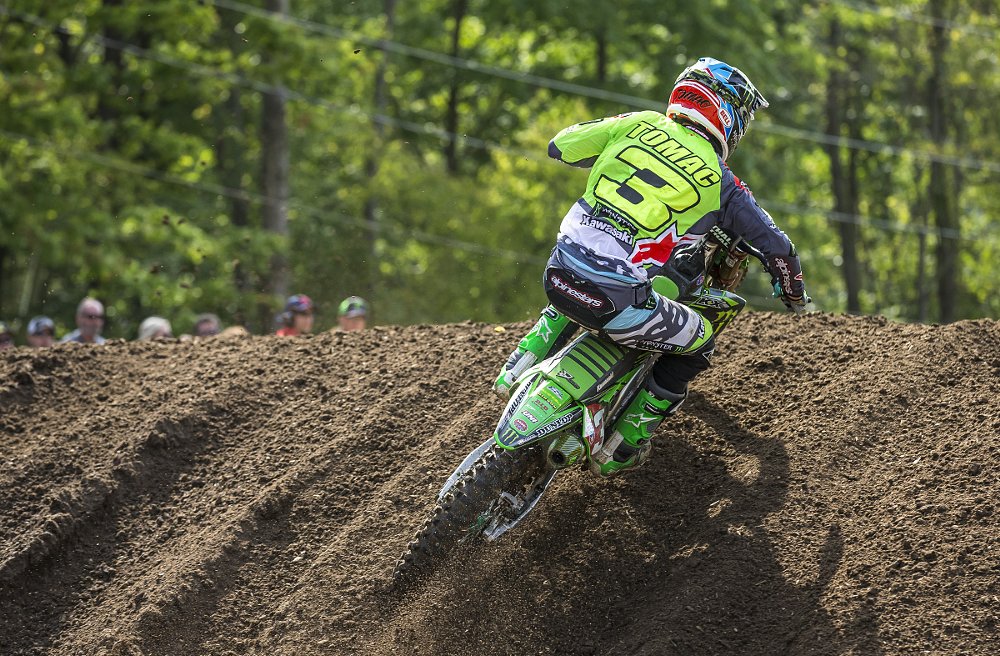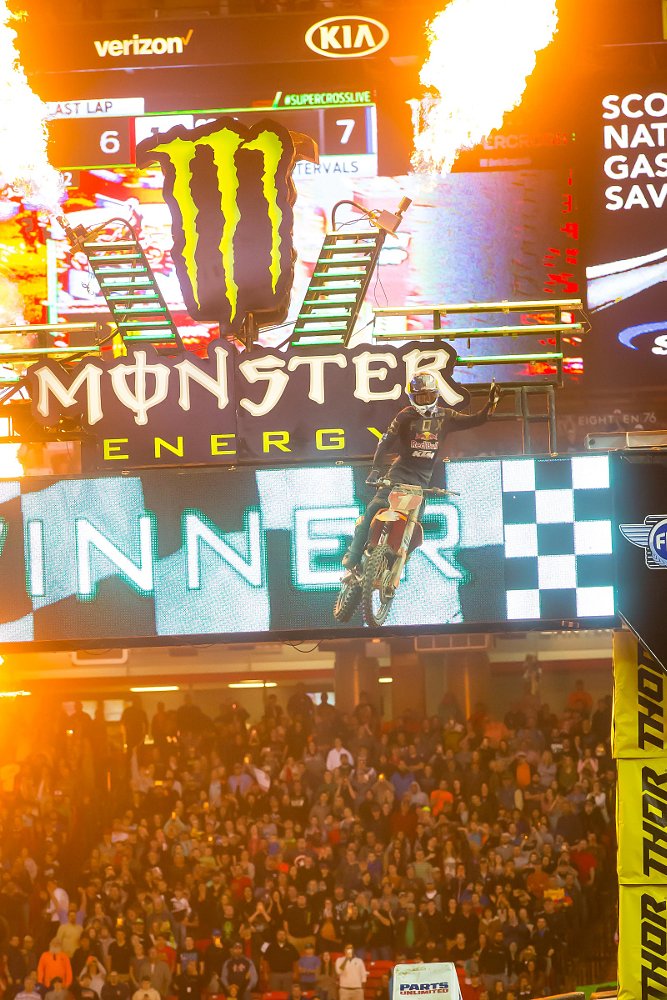For Eli Tomac and Damon Bradshaw, the major changes announced today to the Monster Energy Supercross Championship are one and 26 years too late, respectively.
At a news conference in Tampa, Feld Entertainment Motor Sports announced the most major point standings and formatting changes to the sport of Supercross since 1985. One goal was to maintain the value of winning races while reducing the penalty for inconsistent finishes. You don’t have to look far back into history to see how that changes the outcome of the championship.
Both Tomac and Bradshaw won an astonishing nine main events in a single season but failed to seal their championship bids. Under the new points system to be used in 2018, Tomac would have tied Ryan Dungey in the standings (376/376) and taken the title based on his nine victories to Dungey’s three. Instead, his inconsistency penalized him enough to suffer losing the title by five points.

Core fans were outraged that the most dominant rider of the year could lose the title and many grumbled that Dungey “backed his way” into his fourth championship. In 1992, Bradshaw also won nine mains and lost the title to Jeff Stanton in one of the greatest upsets in the sport’s history.
Well, change is upon us in the Supercross world. This video outlines all the changes.
New points system for Supercross in 2018
| Supercross points system | ||
|---|---|---|
| Position | Current points | 2018 points |
| 1 | 25 | 26 |
| 2 | 22 | 23 |
| 3 | 20 | 21 |
| 4 | 18 | 19 |
| 5 | 16 | 18 |
| 6 | 15 | 17 |
| 7 | 14 | 16 |
| 8 | 13 | 15 |
| 9 | 12 | 14 |
| 10 | 11 | 13 |
| 11 | 10 | 12 |
| 12 | 9 | 11 |
| 13 | 8 | 10 |
| 14 | 7 | 9 |
| 15 | 6 | 8 |
| 16 | 5 | 7 |
| 17 | 4 | 6 |
| 18 | 3 | 5 |
| 19 | 2 | 4 |
| 20 | 1 | 3 |
| 21 | 1 | 2 |
| 22 | 1 | 1 |
Under the new points system, finishes in the top four will see increases of one point each. Everything beyond that gets a two-point bump. This means that on those disastrous nights in the 2017 season, when Tomac finished eighth (twice) and 15th, he would have received two more points each of those races.
“It’s designed to keep the points a little bit closer,” said five-time champion Ricky Carmichael, who was on the panel at the press conference. “That’s what we need. Some riders are going to get a little gift given to them. If they have a bad night, it won’t sting as bad. The best guy is always going to win but it will be a little harder for them to do that.”
New format for Supercross in 2018
In addition to the points system, the format of the night’s racing is also changing.
The major format change is being called a triple crown and will only be implemented at three of the 17 rounds: Anaheim II, Atlanta and Minneapolis. At those events, riders in each racing division (450SX and 250SX) will compete in three separate main events of varying times. For the 450 class, the three main events will be eight, 12 and 15 minutes plus one lap in length. Eighteen of the 22 riders will be chosen during timed qualifying earlier in the day. A last chance qualifier will be run to determine the final four riders on the gate.
While the change in the points structure is something that affects the championship in the long haul — and won’t do much to excite the casual fans — the triple main event format will put the all the biggest stars of the sport on the track at the same time more often. Currently, that only happens once: 20 minutes plus one lap. With three feature races, fans will see Ken Roczen and Tomac and others do battle for a total of 38 to 40 minutes. And with the varying lengths in race time, will new faces rise to the top? That’s something the sport desperately needs.
At the triple crown events, an Olympic-style scoring system will be used to determine a single overall winner of the round. The winner of each main event gets one point, second gets two points, etc. The rider with the fewest total points is awarded the 26 championship points for that round. Skeptics might say it’s confusing for casual fans to have to do math to figure out who the “real” winner is. I get that. It’s a valid argument. My counter is basketball’s three-point line.
There was a time when that points-scoring option didn’t exist. It was tried in the 1960s and went away. In 1979, which happened to be the rookie seasons of Larry Bird and Magic Johnson, the NBA adopted it permanently. Now, basketball without a three-point line is unimaginable. Like that three-point line, three supercross mains of different time lengths could completely change the strategy for Supercross racers. And like in basketball, it’s (sort of) been tried before.

The two main events were 10 laps each at the January 26 opener in San Diego. According to reporting by Kit Palmer in Cycle News, the change “isn’t going over too well with the riders, especially Team Yamaha’s Ricky Johnson. He voiced his opinion over the P.A. system saying that spectators are left feeling ‘stupid’ because they don’t know who finished second of third overall directly after the second moto final. Many riders felt the same way. Nonetheless, the sparse crowd was treated to two very exciting main events.”
In a cruel twist of irony, Johnny O’Mara won the overall by finishing second in both main events. But I believe that spectators — core and casual — want great racing, a battle to the finish every time, an “instant classic,” if you will. They’ll take that over all else. I don’t understand the current NASCAR format one bit but if it’s a good race, I’ll tune in. Same with MotoGP.
When asked if the triple crown format was an experiment toward a season-long, full-format change, Dave Prater, Feld’s director of two-wheel operations was non-committal but didn’t dismiss the notion. If it was well received, “Maybe we’ll increase that to four or five events,” he said.
Other changes to the series include the elimination of the semi qualifiers for riders who were unable to transfer to the main event through the heat races. In 2018, the top nine finishers in the heat races will qualify directly to the main event. All others will try again in the last chance qualifier, which will continue to bump the top four into the 22-rider final. This format puts greater pressure on riders to qualify but it has been tried before. There were no 450SX semi races from 2007-2013.
More 250SX shootouts and amateurs get their hour
In the 250SX regional championships, there will be two East vs. West “shootout” races, where the riders from each division come together to battle. Indianapolis (round 12) will join round 17 in Las Vegas as the other showdown round. Since 1997, the shootout has been exclusive to the Las Vegas finale. From 1985 to 1996, there were two or three shootout events every season.
The final change is the inclusion of four Supercross Amateur racing events on toned down tracks the day after the professionals run. Amateurs in 27 classes will be able to compete at four selected events: Anaheim on January 21, Glendale, Arizona, on January 27, Tampa on February 25 and Atlanta on March 4.
How do you feel about the changes to the sport? Will they make the racing better? It’s understandable that longtime fans are apprehensive of change, that sport organizers should be careful of diluting and dumbing down.
Consider this: Over the past 40 years, track designs, motorcycles, riding gear, training methods, media and money have changed dramatically. Why shouldn’t the format evolve, too?







